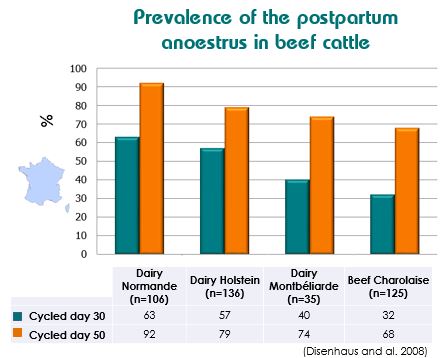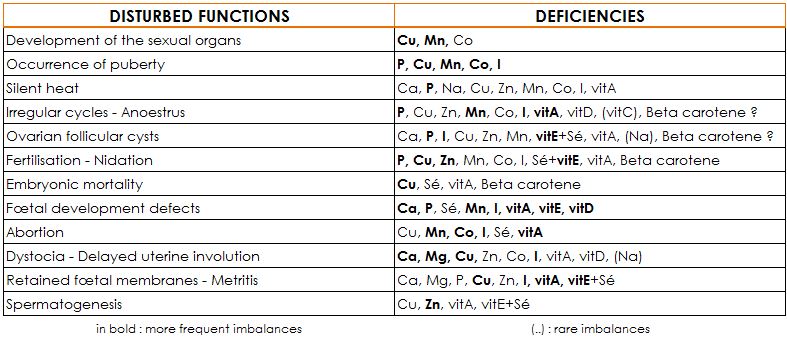Reproduction
In terms of reproduction, leave nothing to chance and enhance your success !
Fertility in cattle herds is a major issue. It is THE area where performance has to be at its best to guarantee the herd’s productivity. Infertility costs can be substantial for the farmer: up to 10% of their gross income.
Direct costs are usually related to multiplication of AI and cannot be neglected (there is 1 failure out of 2 in average during the first AI), especially when we know it is carried out on approximately 78% of dairy cows (52% of exclusive AI) and on 13% of suckler cows (5% of exclusive AI) (1).
Indirect costs come from milk production losses or increase of the renewal rate following culling due to infertility.
In the dairy sector, it is known that most of the incomes come from milk sale (more than 70% of the incomes) (2). To optimize the volume of milk produced by a cow, per day, 4 solutions exist:
- Genetic selection
- Better feeding
- Control of disorders such as mastitis, metritis, etc.
- Increase of the reproductive effectiveness
The latest will have a particular effect on average daily milk production, percentage of milking days and average number of milking days of a herd.
Notable reproductive disorders on farms
Anoestrus
There is no heat, the cycle doesn’t start, ovaries are inactive and feel smooth when doing a transrectal palpation.
Causes are numerous but energy deficit at the start of lactation is the main reason for it. Imbalances in proteins, minerals and vitamins can also be responsible. Everything is a matter of priority: the cow, now a mother, will focus on having a good lactation for her new-born’s survival, at the expense of a new reproduction.
In is only when energetic metabolism will come back to normal, that a new cycle will be able to start. If we look at the figures, it is considered that 35.63 % of dairy primiparous are in anoestrus (3).
In suckler herds, anoestrus post calving is physiological. It is the suckling and presence of the new-born calf that inhibit the start of cyclicity. However, energetical deficit, low NEC at calving or disorders such as metritis can also be responsible.

Suboestrus
Cows don’t express much their heat, which makes their detection difficult. The more oestrogens the cow will produce, the better the heat will express. In suboestrus, the ovaries don’t produce enough of them.
In the same way as the anoestrus, ration imbalances can be responsible (lake of energy, proteins, acidosis). This may be compounded by environmental conditions such as being indoor, slippery ground that can inhibit the expression of heat by the cow.
On the other hand, the time dedicated to heat monitoring by the farmer is often insufficient: it is recommended to observe the animals 3 times per day (early in the morning, at midday and late in the evening), during about 20 minutes each time. This monitoring time will be considered as sufficient to observe 80% of the heat.
Re-breeding
Re-breeding can have two meanings:
- Either there has been fertilisation but the embryo hasn’t survived (25 to 45% of early embryonic mortality estimated for Prim’Holstein (4))
- Or there hasn’t been any fertilisation and a new cycle spontaneously starts
There are multiple reasons for that:
- Significant loss of weight: for a loss of body condition after calving that is over 1 point between 0 and 60 days, we consider a rate of non-fecundation and early embryonic mortality of 41.7% (5)
- A delayed ovulation can lead to a poor AI time (ovulation >24h after the start of the main heat)
- An environment that is not suitable for the embryo such as damaged uterine tube (inflammation, infection) or acidosis, excess of protein in the ration
- An insufficient monitoring time
- A delay in synthesis of progesterone by the corpus lutea will lead to early embryonic mortality between the AI and day 6 (6)
Roles of trace elements and vitamins
There are many of them! In terms of reproduction, considering that rations are well balanced in energy, proteins and macro-elements (Ca, P, Mg etc.), it is essential to focus on these elements.
Here is an overview of their consequences in case of deficiency (7):

The supply strategy has to adapt to the environment
You have time to anticipate reproduction on a cow that you know has issues (like poor expulsion or metritis at calving) ?
You are facing an unexpected issue such as a cow in anoestrus or a cow in suboestrus?
You would like to maximize your chances of having a successful and strong value AI?
Sources :
- http://www.fidocl.fr
- Source Idele.fr
- Ferguson symposium 2003 Impact économique de la performance de reproduction du troupeau
- Année 2009-2010 Ch. Hanzen – L’anoestrus pubertaire et du postpartum dans l’espèce bovine
- Thèse ENVN 2010 Dr GUELOU (NF = Non Fécondation , MEP = Mortalité Embryonnaire Précoce)
- Thèse ENVN 2007 Dr FROMENT
- Meschy 1994
 Contact
Contact Export
Export